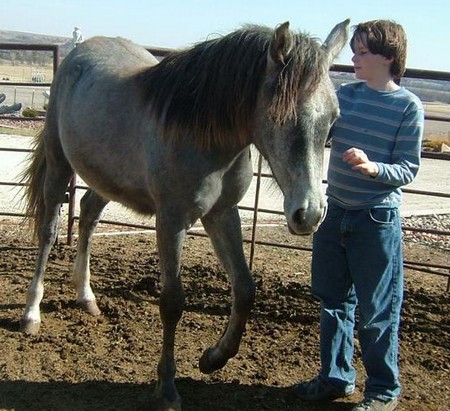Safety is the first and most important consideration when handling your horse-safety for yourself, your horse and anyone around you. Horses are much stronger than humans and boundaries need to be set so that they know their limits.
In the stable
Always let the horse know that you are approaching the stable. If surprised or alarmed, even a good-tempered horse may react violently-kicking out for example. If it is standing near the stable door when you wish to enter, insist that the horse moves back when asked. When in the stable, it should be taught to move its quarters over when requested, in order to give you room to move around. If it turns its back to you, do not chase it around the stable. Instead, turn your own back to the horse and it will soon become inquisitive and turn around. When leading it out of the stable, insist that it waits until the door is opened wide enough to exit and then ask it to walk out calmly. A horse that barges from its stable may injure itself or you.

Leading safely
Most horses are safe enough to lead in a halter, especially when in their home surroundings. In some circumstances, such as when a horse is fresh, unknown to you, or you are in a public place, it is advisable to use a bridle. A bridle gives you more control over the horse as it tends to respect the bit in its mouth.
Generally, a horse is led from its left side, although it is always sensible to ensure that the horse leads from either side. Your right hand should hold the lead rope near to the halter and your left hand takes up the rest of the rope. When leading in a bridle, take the reins over the neck and hold them firmly in both hands, about 10-12 in (25-30 cm) from the bit.
Catching and turning out
When catching a horse, walk into the field and approach the horse quietly and calmly. Some horses will walk toward you to be caught, while others remain eating and wait for you to walk to them. If you have to approach, make sure that the horse has seen you and knows you are coming. Remain calm, placing the lead rope around its neck and then putting on the halter. Lead the horse quietly and steadily to the gate.
When turning out a horse, lead it into the field, walking on its left. Make sure it stands while you either unclip the lead rope – if leaving the halter on-or gently and quietly remove the halter. When the horse is loose, do not flap your arms or smack it with the halter to send it on into the field, as this will teach the horse to bolt or possibly kick out.
Tying up
A horse must always be tied up using a quick-release knot. Never tie up a horse in a way that cannot be undone speedily if the circumstances dictate. A horse that is startled or frightened while tied up may panic and pull back, which could result in damage to itself, people or property. If you’re considering buying Driving Carriages to use your horse for transportation, check out CarriageMart’s products on their site.